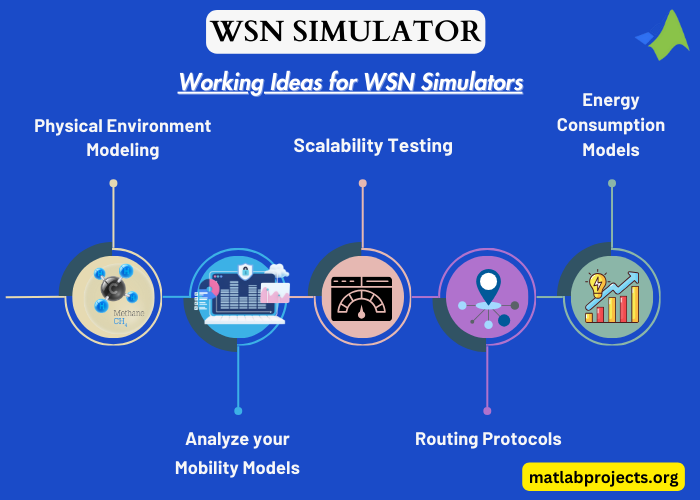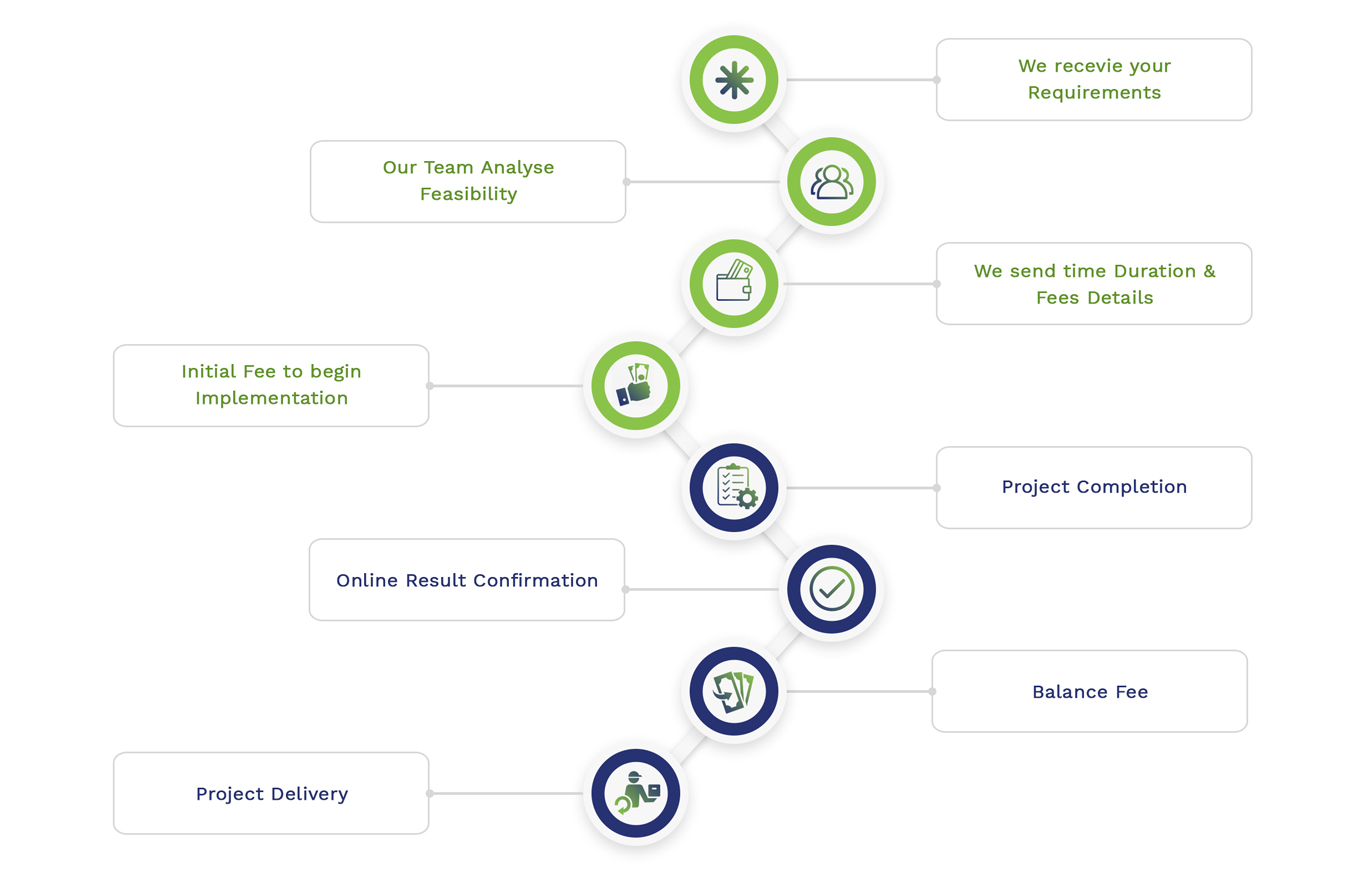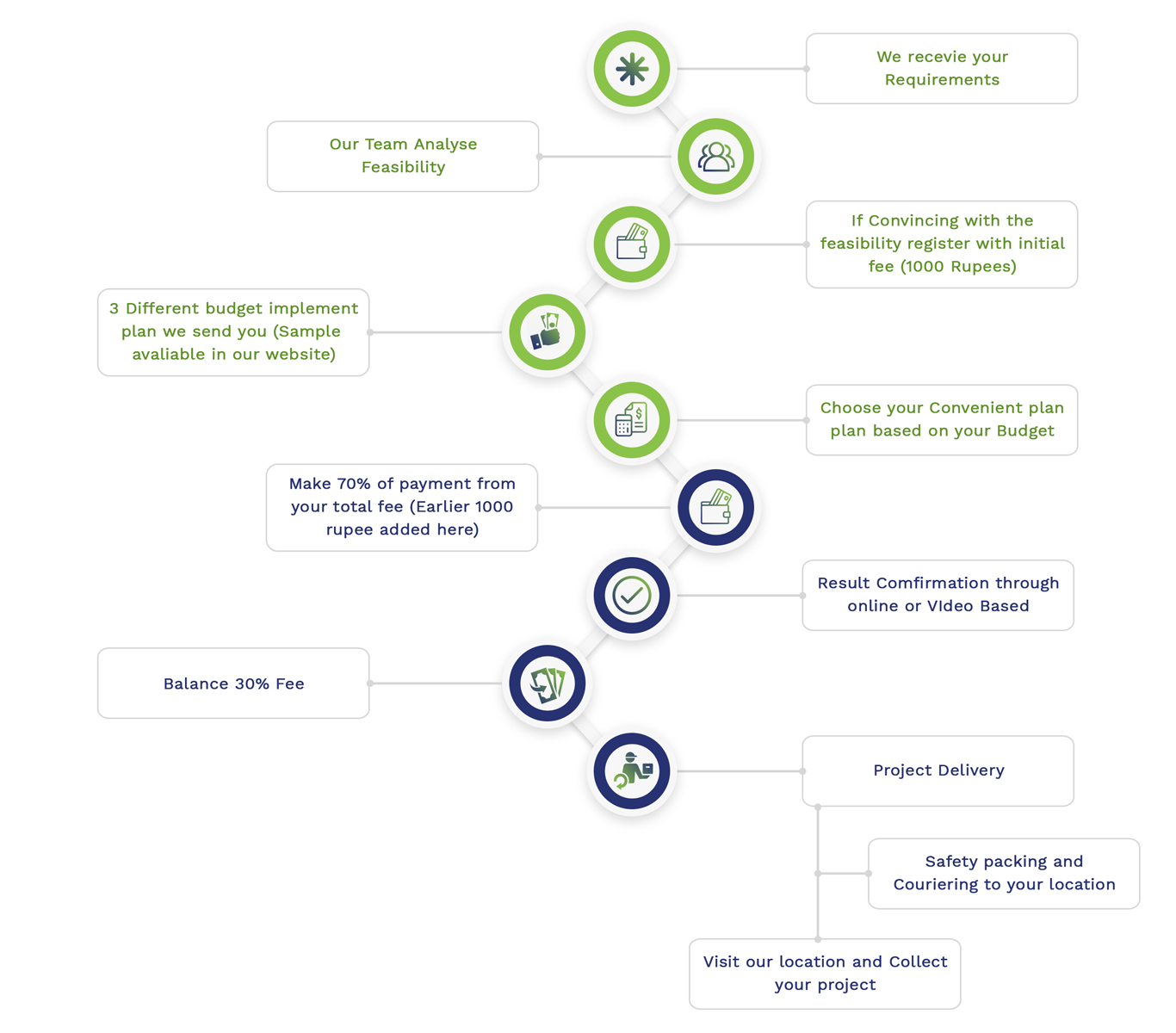There are several working ideas, simulators, and areas of application in the domain of Wireless Sensor Network (WSN), but some are determined as efficient. Leading simulation tools are used by our as per your related concept. Avail of our thesis writing services at matlabprojects.org to receive a meticulously crafted thesis that aligns with your academic standards. Below we describe few extensive working ideas, regions of application, and prominent simulators for WSNs:
Detailed Working Ideas for WSN Simulators:
- Energy Consumption Models: A major factor of WSN simulation is designing and enhancing energy usage, as sensor nodes are generally battery-powered. Different energy-conserving methods and protocols, like duty cycling, energy-effective routing, and data collection approaches can be investigated by simulations.
- Routing Protocols: Specifically, for data transmission, the simulation of routing protocols in WSNs are determined as significant. According to different parameters such as latency, scalability, throughput, and energy utility, protocols can be assessed. Mainly, for simulation the prominent routing protocols encompass PEGASIS, ZRP, and LEACH.
- Scalability Testing: To examine the scalability of networks, WSN simulations can be utilized. In order to assess the effectiveness and challenges of network protocols and methods, this includes the process of simulating networks with differing sizes that is from some nodes to thousands.
- Mobility Models: Generally, simulations should integrate mobility frameworks in the setting where sensor nodes or the base station are mobile. The movement trends of nodes are simulated by these frameworks, which is examined as significant for applications such as calamity management or wildlife monitoring.
- Realistic Physical Environment Modeling: Simulations can involve systems of real-time events like humidity ranges, temperature changes for applications such as farming or ecological tracking, in order to evaluate how efficiently the network can gather and document data under varying situations.
Areas of Application:
- Environmental Monitoring: Typically, for ecological metrics like humidity, temperature, and pollutant levels, WSNs are extensively employed. The simulations can be useful in formulating networks that have the capability to effectively comprise wide regions and adjust to ecological variations.
- Healthcare: In the area of healthcare, WSNs track significant indications of patients or assure the suitable platform in hospitals. In this region, the simulation concentrates on data precision, consistency, and actual-time data processing.
- Smart Homes and Cities: For smart homes and cities, WSN simulations concentrate on incorporating sensors with IoT devices mainly for applications such as protection, urban scheduling, and energy management.
- Agriculture: From WSNs, area of agriculture gains advantages in accurate farming, where simulations assist in formulating frameworks for tracking crop welfare, soil dampness, and enhancing usage of water.
- Military: Particularly, for military applications WSN simulations highlight safety protocols, strength, and the capacity to function in difficult platforms.
Popular WSN Simulators:
- NS-2/NS-3: For network simulations involving WSNs, it is extensively utilized. Generally, for simulating various protocols and platforms, they provide wide-ranging libraries.
- OMNeT++: Generally, it is employed for simulating different kinds of networks such as WSNs. OMNeT++ is a modular simulation platform that is extremely adaptable.
- Castalia: According to OMNeT++, Castalia is formulated mainly for WSNs. Typically, it is suitable for simulating less-power, wireless sensor networks in practical platforms.
- Cooja: The simulator Cooja is the segment of the Contiki OS environment. It permits the simulation of networks encompassing microcontroller nodes as well as more abstract network nodes.
Can I simulate wireless sensor networks in python? If yes can you provide the links?
Python-related simulation might need more foundation in contrast to contributed network simulation tools such as OMNeT++, Castalia, or NS-3. Because, you might have to either construct a few of the simulation logic on your own or utilize general-purpose libraries.
For simulating factors of WSNs or network simulations in common, the following are some of the python tools and libraries that could be employed:
- SimPy: Especially, SimPy is not formulated for WSNs. It is a process-related discrete-event simulation model, which is extremely flexible and can be utilized to design WSN incidents, activities, and protocols. For your sensor nodes, you can develop custom simulation platforms, describe their communications, and design the dynamics of the network gradually.
- SimPy on GitHub
- NetworkX: For the development, utilization, and research of complicated networks of nodes and edges, NetworkX is a python library. Encompassing the correlations and interaction paths among nodes, it can be employed to design the topology of WSNs. It is beneficial for interpreting the network architecture and formulating routing methods, but it does not contain the capability to simulate network congestion or protocols in a direct manner.
- NetworkX Documentation
- Pymote: For simulation of distributed methods such as those utilized in WSNs, Pymote is an extensive python library. Specifically, for the model, simulation, and exploration of methods for WSNs, it intends to offer a basic platform. It is significant to assess Pymote’s appropriateness for your certain requirements, as its advancement and assistance might be constrained.
- Pymote GitHub Repository
- Mininet-WiFi: For WSN simulations, Mininet-WiFi could be adjusted, even though it is more concentrated on software-defined networking (SDN) and wireless networks. The simulation of a network with switches, virtual hosts, controllers, and links, are permitted. The abilities of Mininet are expanded by Mininet-WiFi in order to assist WiFi networks that could be helpful for simulating specific kinds of WSN settings.
- Mininet-WiFi on GitHub
While employing these tools, aim to integrate them in order to attain your anticipated simulation platform. For instance, you might employ NetworkX to design the network topology and SimPy to simulate the common factors of function of a network.

WSN Simulator Thesis Ideas
WSN Simulator Thesis Ideas service offers a complete research platform where you can explore innovative ideas and fresh research concepts presented by our experienced professionals. Our team of experts is dedicated to providing valuable research ideas to students and scholars. We also offer customized WSN Simulator research topics to cater to your specific interests with the assistance of our renowned experts.
- Secrecy performance analysis of IRS-assisted D2D communication underlaying cellular network
- An in silico and in vitro human neuronal network model reveals cellular mechanisms beyond NaV1.1 underlying Dravet syndrome
- Cooperative non-orthogonal multiple access with D2D communication and opportunistic relaying in large-scale cellular networks
- Deep reinforcement learning-based resource allocation for D2D communications in heterogeneous cellular networks
- Spectrum efficiency maximization for multi-hop D2D communication underlaying cellular networks: Machine learning-based methods
- Fairness-aware resource allocation for D2D-enabled IoT in NOMA-based cellular networks with mutual successive interference cancellation
- Cognitive radio based spectrum sharing models for multicasting in 5G cellular networks: A survey
- Enhancement in Quality-of-Services using 5G cellular network using resource reservation protocol
- Cognitive radio based spectrum sharing models for multicasting in 5G cellular networks: A survey
- Performance analysis of coverage-centric heterogeneous cellular networks using dual-slope path loss model
- Cellular Network Capacity and Coverage Enhancement with MDT Data and Deep Reinforcement Learning
- Multiplexed kinase interactome profiling quantifies cellular network activity and plasticitysis of coverage-centric heterogeneous cellular networks using dual-slope path loss model
- Cellular Network Capacity and Coverage Enhancement with MDT Data and Deep Reinforcement Learning
- Modelling heterogeneous future wireless cellular networks: An analytical study for interaction of 5G femtocells and macro-cells
- Low-loss and dual-band filter inspired by glide symmetry principle over millimeter-wave spectrum for 5G cellular networks
- Joint access and backhaul resource allocation for D2D-assisted dense mmWave cellular networks
- Spatio-temporal analysis and cellular automata-based simulations of biophysical indicators under the scenario of climate change and urbanization using artificial neural network
- A queueing theory approach to traffic offloading in heterogeneous cellular networks
- A lightweight traceable D2D authentication and key agreement scheme in 5G cellular networks
- Dynamic Spectrum Control-Assisted Secure and Efficient Transmission Scheme in Heterogeneous Cellular Networks
Subscribe Our Youtube Channel
You can Watch all Subjects Matlab & Simulink latest Innovative Project Results
Our services
We want to support Uncompromise Matlab service for all your Requirements Our Reseachers and Technical team keep update the technology for all subjects ,We assure We Meet out Your Needs.
Our Services
- Matlab Research Paper Help
- Matlab assignment help
- Matlab Project Help
- Matlab Homework Help
- Simulink assignment help
- Simulink Project Help
- Simulink Homework Help
- Matlab Research Paper Help
- NS3 Research Paper Help
- Omnet++ Research Paper Help
Our Benefits
- Customised Matlab Assignments
- Global Assignment Knowledge
- Best Assignment Writers
- Certified Matlab Trainers
- Experienced Matlab Developers
- Over 400k+ Satisfied Students
- Ontime support
- Best Price Guarantee
- Plagiarism Free Work
- Correct Citations
Expert Matlab services just 1-click

Delivery Materials
Unlimited support we offer you
For better understanding purpose we provide following Materials for all Kind of Research & Assignment & Homework service.
 Programs
Programs Designs
Designs Simulations
Simulations Results
Results Graphs
Graphs Result snapshot
Result snapshot Video Tutorial
Video Tutorial Instructions Profile
Instructions Profile  Sofware Install Guide
Sofware Install Guide Execution Guidance
Execution Guidance  Explanations
Explanations Implement Plan
Implement Plan
Matlab Projects
Matlab projects innovators has laid our steps in all dimension related to math works.Our concern support matlab projects for more than 10 years.Many Research scholars are benefited by our matlab projects service.We are trusted institution who supplies matlab projects for many universities and colleges.
Reasons to choose Matlab Projects .org???
Our Service are widely utilized by Research centers.More than 5000+ Projects & Thesis has been provided by us to Students & Research Scholars. All current mathworks software versions are being updated by us.
Our concern has provided the required solution for all the above mention technical problems required by clients with best Customer Support.
- Novel Idea
- Ontime Delivery
- Best Prices
- Unique Work
Simulation Projects Workflow

Embedded Projects Workflow



 Matlab
Matlab Simulink
Simulink NS3
NS3 OMNET++
OMNET++ COOJA
COOJA CONTIKI OS
CONTIKI OS NS2
NS2






